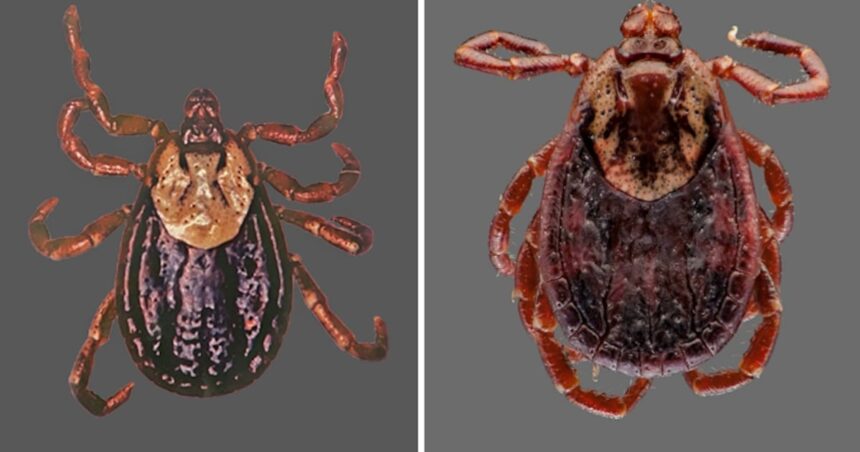In the quiet riverside town of Port Hope, Ontario, Angela Moretti kneels in her garden, carefully checking her golden retriever’s thick coat. “It’s become part of our routine now,” she says, gently parting Cooper’s fur. “Every time we come in from outside, especially after walking near the conservation area.”
What Moretti is searching for are ticks – tiny arachnids that have become increasingly common across Ontario and carriers of potentially devastating diseases. Two months ago, Cooper was diagnosed with Rocky Mountain Spotted Fever (RMSF), a tick-borne illness that, until recently, was rarely seen this far north.
“It started with lethargy. He wouldn’t eat, and then came the fever,” Moretti recalls. “By the time the spots appeared on his gums, we were already at the emergency vet.”
Cooper recovered after aggressive antibiotic treatment, but his case represents a troubling trend that veterinarians across Ontario are monitoring closely. RMSF, historically limited to the southern United States and parts of Mexico, has gradually expanded northward as warming temperatures create hospitable environments for the ticks that transmit it.
Dr. Samira Patel, a veterinarian at Lakeshore Animal Hospital in Toronto, has treated three cases of RMSF in the past year. “Five years ago, I might have seen one case in my entire career here,” she explains during a brief break between appointments. “The change has been dramatic and concerning.”
The disease is primarily transmitted by the American dog tick and the brown dog tick, both of which have established populations in southern Ontario. Unlike Lyme disease, which requires ticks to be attached for 24-36 hours to transmit the bacteria, RMSF can be transmitted in as little as two to ten hours of attachment.
“That’s what makes it particularly dangerous,” says Dr. Patel. “Even responsible pet owners who check regularly might miss that window.”
According to data from the Ontario Veterinary Medical Association, reported cases of RMSF in dogs increased by 34% between 2022 and 2024, with most cases concentrated in southern Ontario, particularly around the Greater Toronto Area and along the shores of Lake Ontario and Lake Erie.
The symptoms can be devastating and rapid. Dogs typically develop fever, lethargy, and decreased appetite within two to fourteen days of being bitten by an infected tick. As the disease progresses, they may experience vomiting, diarrhea, joint pain, and the characteristic spotted rash on their gums, belly, and ears that gives the disease its name.
For Brenda Kheir of Hamilton, the experience was terrifying. Her terrier mix, Pepper, went from playful to critically ill within days. “The vet told us if we’d waited another 24 hours, we might have lost him,” Kheir says, watching Pepper chase squirrels in Gage Park. “Now I check him obsessively, and we avoid tall grass completely.”
But it’s not just pets at risk. RMSF can also affect humans, causing similar symptoms and potentially life-threatening complications if left untreated. Dr. Eleanor Frost, an infectious disease specialist with Public Health Ontario, notes that while human cases remain relatively rare in the province, the increasing prevalence in pets serves as an early warning system.
“Dogs are sentinels for human disease,” Dr. Frost explains. “They’re often exposed to ticks before humans are, so when we see RMSF increasing in the pet population, it suggests human cases may follow without proper awareness and prevention.”
Prevention remains the best approach for both pets and their owners. Veterinarians recommend year-round tick prevention for pets, even during colder months when adult ticks may still be active during warm spells.
Dr. Patel advises pet owners to use veterinarian-approved tick preventatives, conduct thorough tick checks after outdoor activities, and remove any attached ticks promptly using fine-tipped tweezers or a tick removal tool.
“Grasp the tick as close to the skin’s surface as possible and pull upward with steady pressure,” she demonstrates on a model during a community education session at a local park. “Don’t twist or jerk, as this can cause the mouth parts to break off in the skin.”
Environmental management also plays a role. Keeping lawns mowed, removing leaf litter, and creating barriers between wooded areas and yard spaces with gravel or wood chips can reduce tick habitats around homes.
The Public Health Agency of Canada has incorporated RMSF into its tick surveillance programs, which previously focused primarily on Lyme disease. Scientists at the National Microbiology Laboratory in Winnipeg are now regularly testing ticks submitted from Ontario for the Rickettsia rickettsii bacteria that causes RMSF.
For communities in tick hotspots, adaptation has become necessary. In Prince Edward County, where tourism and outdoor activities drive the local economy, businesses and conservation areas have installed tick checking stations equipped with mirrors, lighting, and educational materials.
“We can’t stop people from enjoying the outdoors, nor should we,” says Michael Tummon, who manages a popular hiking trail system near Picton. “But we can help them protect themselves and their pets.”
Back in Port Hope, Angela Moretti has become something of a neighborhood advocate, organizing community workshops on tick prevention and creating a support network for pet owners dealing with tick-borne illnesses.
“Cooper’s experience changed me,” she says, watching her now-recovered dog splash in the shallow waters of the Ganaraska River. “I realized how quickly these diseases can take hold, and how little many of us knew about the risks.”
As climate change continues to alter the ecological landscape of Ontario, experts predict that RMSF and other tick-borne diseases will likely become more common. The key to protection, they emphasize, lies in awareness, vigilance, and prompt veterinary care when symptoms appear.
“This isn’t about fear,” Dr. Patel insists. “It’s about adapting to a changing environment and taking simple steps to protect the animals we love.”






